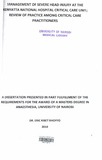| dc.contributor.author | Bhoyyo, Eric K | |
| dc.date.accessioned | 2014-01-22T05:43:26Z | |
| dc.date.available | 2014-01-22T05:43:26Z | |
| dc.date.issued | 2010 | |
| dc.identifier.citation | Masters Degree In Anaesthesia | en_US |
| dc.identifier.uri | http://hdl.handle.net/11295/64152 | |
| dc.description | A Dissertation Presented In Part Fulfillment Of The
Requirements For The Award Of A Masters Degree In
Anaesthesia, University Of Nairobi | en_US |
| dc.description.abstract | Severe head injury represents a major contributor to patients in the CCU where their care falls under
a multi-disciplinary team requiring immense resource utilization. Currently about 20% of mortality in
the Kenyatta National Hospital, Critical Care Unit (KNH-CCU) can be directly attributed to severe
head injury. Outcome of care heavily depended on the correct management of secondary insults after
the initial injury which must begin at the primary trauma survey.
The objective of the study was to review the current management of patients with severe head injury
in the critical unit by the anaesthesia and neurosurgery practitioners, and to compare it with
recommended Brain Trauma Foundation guidelines on the care of severely head-injured patients.
The study was a cross-sectional, survey in which a self administered questionnaire was used to
collect data from critical care practitioners in Kenyatta National Hospital Critical Care Unit. Consent
was duly obtained prior to the study from each of the participants who comprised both anesthesia and
neurosurgery practitioners, and there were both consultants and senior Post Graduates students in
each category.
Data from the 53 practitioners sampled mainly focused on various aspects of severely head-injured
patient care. Majority of practitioners comprised the anesthesia providers. The Glasgow Coma Scale
was found to be a key clinical assessment and evaluation tool among 80% of participants sampled.
On further evaluation of key secondary insults contributing to poor outcome, responses were
compared to Brain Trauma Foundation guidelines and the survey revealed only 20% of practitioners
correctly managed hypotension. Hypoxia was correctly managed by 69% and blood glucose and
carbon dioxide levels were 63% and 54% respectively. Key challenges in patient care revealed many
resource limitations with limited CCU bed space and delayed surgical intervention standing out.
Conclusions and Recommendations:
Severe head injury management in the KNH-CCU did not meet recommended international
guidelines (BTF) and a protocol was necessary to guide current management practices. | en_US |
| dc.language.iso | en | en_US |
| dc.publisher | University Of Nairobi | en_US |
| dc.title | Management of severe head injury at the Kenyatta national hospital critical care unit; Review of practice among critical care Practitioners | en_US |
| dc.type | Thesis | en_US |
| dc.description.department | a
Department of Psychiatry, University of Nairobi, ; bDepartment of Mental Health, School of Medicine,
Moi University, Eldoret, Kenya | |

